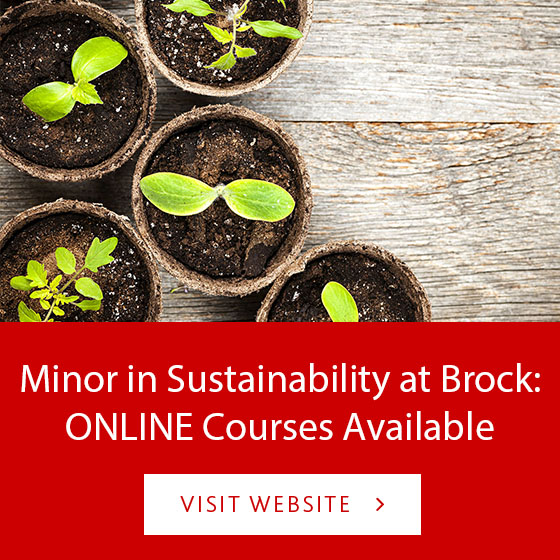By: Lydia Collas

SSAS students attend the AAG 2017 Annual Meeting in Boston to present their research. From left to right, Tyler Prince, Cait Garner, Zach Harmer, Dan Hughes (Earth Sciences) and Dana Harris.
Four students from Brock’s Master of Sustainability (SSAS) program travelled to Boston last month to attend the American Association of Geographers (AAG) 2017 Annual Meeting. I spoke to Cait Garner, Zach Harmer, Dana Harris and Tyler Prince to get their perspectives on presenting their research at the five-day conference which hosted more than 7,000 geographers from around the world.
Attending a conference of this size had clearly left its mark on all of them. SSAS student Tyler Prince said, “It was a great experience all around. AAG is a great place to showcase your own research as well as learn about other innovative research being done in your field of study.”
Prince’s research involves postglacial reconstruction of the fire history from a small lake in southwest Yukon Territory. “In a time of uncertainty with climate change, lake sediment records are extremely useful to help predict future conditions. Increasing temperatures are leading to more fires and larger fires. This record provides a look into the past 12,000 years for southwest Yukon, providing insight on how fire responds to changes in climate.” Prince’s presentation won him the award for the Best Master’s student presentation from the Biogeography specialty group!
Cait Garner said of the trip “AAG was great. I met a lot of amazing researchers at the conference. Some presentations inspired me to explore areas of my own research that I had previously not committed much thought to.”
Garner’s research is concerned with the impacts of wildfires on northern stream ecosystems. “My presentation was a summary of impacts of recent wildfires (2014-2016) on stream water chemistry and benthic invertebrates within the North Slave, South Slave, and Dehcho regions of the Northwest Territories. Preliminary results suggest that large perturbations in water chemistry occur following periods of higher precipitation in recently burned areas. In addition, burned streams tended to be dominated by invertebrate taxa that reflect large amounts of finer material moving into the water column from the surrounding catchment.”
Similarly impressed with the event was Zach Harmer, “The AAG Annual Meeting was spectacular! The opportunities are endless while attending this conference as a graduate student; discussing your research and sharing ideas with academics, meeting fellow graduate students, creating contacts from other institutions.”
Harmer’s research looks at identifying spatial patterns of landscape changes and its influence on water chemistry in the northern Niagara Region, Canada, “My research takes aim at evaluating the relationships between land use/land cover change and water chemistry in small catchments. The northern reaches of the Niagara Region have witnessed transitions in agricultural types, specifically from orchards to vineyards since mid-2000s. Identifying how this transition influences water chemistry at downstream sample locations are key for stakeholders as more potential development occurs.”
Whilst her colleagues are approaching the end of their time in the SSAS program, Dana Harris began a year later, in September 2016. Harris said of the event, “The conference was
massive! It was a really great opportunity to present the basic skeleton of my project at an event like this.”
Harris’ research looks to assess the factors influencing the growth and cellular development of jack pine in Yellowknife, Northwest Territories, “My research aims to identify the climate-growth relationship of the jack pine tree species within its northern species limit in the Yellowknife, NT region. This will be assessed through quantifying growth through the analysis of cellular development that occurs over the course of the presumed growing season.”
When I asked the students about the highlight of their trip, it seems that there were too many to single out just one. Academically, they all mentioned the excitement of watching each other excel in their presentations, as well as being able to showcase and talk to others about their own research. Outside of the conference, highlights included watching a baseball game at Fenway Park, becoming New England clam chowder connoisseurs and even “running statistical analyses on the different types of waffle fries offered by Boston restaurants…”.
Cait, Zach, Dana and Tyler’s research is supervised and supported by Drs. Michael Pisaric and Kevin Turner. All four SSAS students are members of the Water and Environmental Laboratory (WEL) at Brock University. The ESRC is delighted to congratulate the students on a very successful trip.
